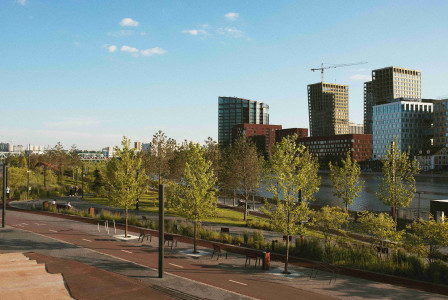Articles
07 April 2025
Revitalising Cities: Sustainable Urban Regeneration for a Resilient Future
Articles
07 April 2025
Regenerative Green Transition
Urban and Rural Wellbeing
Proximity and social economy
+6 more
-
269

Urban regeneration revitalises underused urban areas to improve economic, social, and environmental conditions. Key strategies include densification, community engagement, and integrating green infrastructure.
The European Commission’s New European Bauhaus initiative supports sustainable, inclusive development. While offering many benefits, urban regeneration faces challenges like financial constraints and gentrification, requiring adaptive, collaborative approaches to ensure equitable outcomes.
Topics
EU-27
International Organisations
NGOs / Non-profits
-
Thematic area
-
-
Regenerative Green Transition
-
Urban and Rural Wellbeing
-
-
Interlinkages with other sectors
-
-
Proximity and social economy
-
Construction
-
Cultural and creative industries
-
-
Action areas and keywords
-
-
Local Green Deals, green business communities and citizens’ initiatives
-
Sustainable Finance
-
-
Ecosystem focus
-
-
Social economy
-
-
Scope of activity
-
-
International
-
Share
Urban regeneration is a process aimed at revitalising underutilised or declining urban areas to improve economic, social, and environmental well-being. As cities face growing challenges such as population growth, economic changes, and environmental concerns, strategic urban regeneration initiatives offer opportunities to create more inclusive, resilient, and vibrant communities. Cities worldwide are experiencing significant shifts, including increased urbanisation and aging infrastructure. Without strategic intervention, these trends can lead to declining neighbourhoods, social inequality, and environmental degradation. Urban regeneration seeks to address these challenges by bringing underutilised assets back into productive use (involve converting abandoned or underused buildings into new community spaces, affordable housing, or commercial properties), improving living standards, and redistributing opportunities across urban spaces.
Strategies for Successful Urban Regeneration
Successful urban regeneration relies on a combination of strategic approaches that promote sustainability, inclusivity, and economic revitalization. One key approach is densification, which maximises the use of existing land to accommodate population growth while enhancing infrastructure and public services. This strategy fosters walkable, liveable neighbourhoods and generates revenue for urban maintenance. Equally important is community engagement and social inclusion, ensuring that development benefits existing communities rather than displacing them. Research highlights the need to involve local enterprises and residents in decision-making processes to achieve equitable regeneration without gentrification. Community-driven projects help foster a sense of ownership and long-term sustainability.
Economic revitalisation plays a crucial role in urban regeneration by attracting investment, creating jobs, and repurposing abandoned spaces into commercial or cultural hubs. Strategic planning aligns redevelopment efforts with the economic needs of residents, preventing displacement and fostering long-term prosperity. Another important aspect is the integration of green and smart infrastructure. Sustainable urban regeneration incorporates green spaces, energy-efficient buildings, and improved public transport to enhance environmental resilience and quality of life. Additionally, digital solutions such as smart city technology optimise resource use and improve urban efficiency.
The Role of the European Commission and the New European Bauhaus
The European Commission plays a key role in supporting urban regeneration initiatives, particularly through the New European Bauhaus program (NEB). This initiative, launched as part of the European Green Deal, aims to bridge sustainability, aesthetics, and inclusivity in urban development. The NEB’s emphasis on green design and circular economy principles supports the environmentally conscious transformation of urban areas, making them more sustainable. It also focuses on social regeneration by promoting inclusivity, reducing inequalities, and improving the quality of life within communities. Additionally, the NEB's strong focus on creativity and cultural industries aligns with how these sectors can drive urban revitalization, making spaces more vibrant and engaging. The initiative also works to bridge the gap between urban and rural areas, ensuring balanced regeneration and sustainable development across regions. Overall, the NEB’s values provide a comprehensive framework for fostering positive social, environmental, and economic changes in urban regeneration.
Challenges
Despite its benefits, urban regeneration faces challenges such as financial constraints, resistance to change, and balancing redevelopment with affordability. Many regenerations projects risk prioritising economic gains over social equity, leading to gentrification and the displacement of lower-income residents.
Ensuring that urban regeneration remains inclusive requires policies that protect affordable housing and support existing communities. Urban regeneration is an evolving process that requires adaptive strategies and collaborative governance. Cities can develop innovative approaches to revitalization by fostering partnerships between governments, business, and communities.
Documents
Comments (0)
See also
Financing the Ecosystem Recap: December – January
- Categories
- Partnerships Regenerative Green Transition Skills +68 more
Video Tutorial: Unlock All Features of the EU Proximity and Social Economy Platform
- Categories
- Partnerships Regenerative Green Transition Skills +68 more
PSE Platform Ambassador highlight: Giorgio Nanni and Legacoop
- Categories
- Partnerships Regenerative Green Transition Skills +68 more




